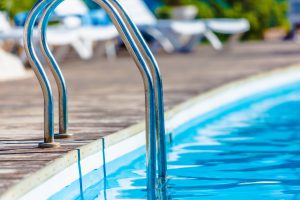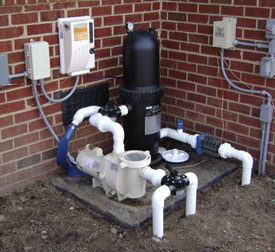Pool Safety
Pool Maintenance and Safety
 Let your mind drift to images of summer. The sun is out and the water is glistening. What more do you need? Except for a running start for the first cannonball of the season. However, wait. Is your pool truly ready for the summer? When is the last time you checked that pH balance or checked the filtration system? Before you or your family jump in, there are some steps that need to be taken to ensure health safety and a full summer of enjoyment.
Let your mind drift to images of summer. The sun is out and the water is glistening. What more do you need? Except for a running start for the first cannonball of the season. However, wait. Is your pool truly ready for the summer? When is the last time you checked that pH balance or checked the filtration system? Before you or your family jump in, there are some steps that need to be taken to ensure health safety and a full summer of enjoyment.
Health Hazards
Despite what the general population may think, chlorine does not kill all germs instantly. If fact, plenty of germs are tolerant to chlorine! These are known as Recreational water illnesses and can be spread by swallowing, breathing in mist or having contact with contaminated water. According to the Center for Disease Control, Crypto (Cryptosporidium), Giardia, Shigella, Norovirus and E.coli are the main culprits associated with RWI’s. These germs can cause infections in the respiratory, neurological and gastrointestinal systems. In addition, cases of infections in the skin, ears and eyes. Though all of these infections are possible, the most common is gastrointestinal illnesses or diarrhea.
Preventative Measures
 While Chlorine is not a cure all, it does play a very important role in protecting you against germs that can make swimmers ill, as does monitoring pH levels. Which is why routinely checking and maintaining chlorine levels is your best line of defense. Chlorine levels can be affected by many things, ranging from debris, sunlight, dirt to anything brought in with a humans’ body. In addition to its fickle nature, it takes time for chlorine to work. The ideal level of chlorine ranges from 1.0 – 3.0 ppm. That is a very small range and it requires close monitoring and planning on your part.
While Chlorine is not a cure all, it does play a very important role in protecting you against germs that can make swimmers ill, as does monitoring pH levels. Which is why routinely checking and maintaining chlorine levels is your best line of defense. Chlorine levels can be affected by many things, ranging from debris, sunlight, dirt to anything brought in with a humans’ body. In addition to its fickle nature, it takes time for chlorine to work. The ideal level of chlorine ranges from 1.0 – 3.0 ppm. That is a very small range and it requires close monitoring and planning on your part.
Chlorine is just one part of the dynamic duo that allows for safe summertime fun. Don’t forget about pH, it plays a role in how effective the chlorine will be against germs. The higher the pH, the less ability the chlorine has to be effective and vice versa. Another factor to keep in mind is that a human body has a pH level between 7.2 and 7.8, any amount outside of that range and swimmers could have to deal with irritation of the eyes and skin. Keeping an eye on these two disinfecting tools will get you one step closer to the perfect summer.
Continuous Maintenance
 Yes, chores are annoying. Jumping into a pool and coming up with a mouth full of leaves would be worse, wouldn’t you agree? The steps are relatively simple and low in cost (compared to the cost of your pool!) Skimming the surface of the pool for floating debris and setting up a vacuum to collect what is on the floor of the pool takes all of 15-45 minutes to complete. Not to mention the meditative nature of the chore. It’s a win-win! In addition to keeping debris out, it is also important to check on the filter. Backwashing the filter allows you to maintain that idyllic crystal clear water we are all so fond of. Cleaning out the pump filter is important, but it is not necessary to clean regularly. This is because, in conjunction with the diatomaceous earth, cartridge or sand that is used in the filter, extra dirt would only help the filtration process. Simply put, a less clean filter is less efficient. Check your pressure gauge and flow meter. If there is an increase in flow, then it may be time to clean.
Yes, chores are annoying. Jumping into a pool and coming up with a mouth full of leaves would be worse, wouldn’t you agree? The steps are relatively simple and low in cost (compared to the cost of your pool!) Skimming the surface of the pool for floating debris and setting up a vacuum to collect what is on the floor of the pool takes all of 15-45 minutes to complete. Not to mention the meditative nature of the chore. It’s a win-win! In addition to keeping debris out, it is also important to check on the filter. Backwashing the filter allows you to maintain that idyllic crystal clear water we are all so fond of. Cleaning out the pump filter is important, but it is not necessary to clean regularly. This is because, in conjunction with the diatomaceous earth, cartridge or sand that is used in the filter, extra dirt would only help the filtration process. Simply put, a less clean filter is less efficient. Check your pressure gauge and flow meter. If there is an increase in flow, then it may be time to clean.
Be sure to always keep an eye out for crack and leaks, preventative measures will save you money in the long run. If problems arise that are out of your comfort zone, you can always call a professional!
References
http://www.cdc.gov/healthywater/swimming/pools/disinfection-team-chlorine-ph.html
http://www.thisoldhouse.com/toh/how-to/intro/0,,20051390,00.html
